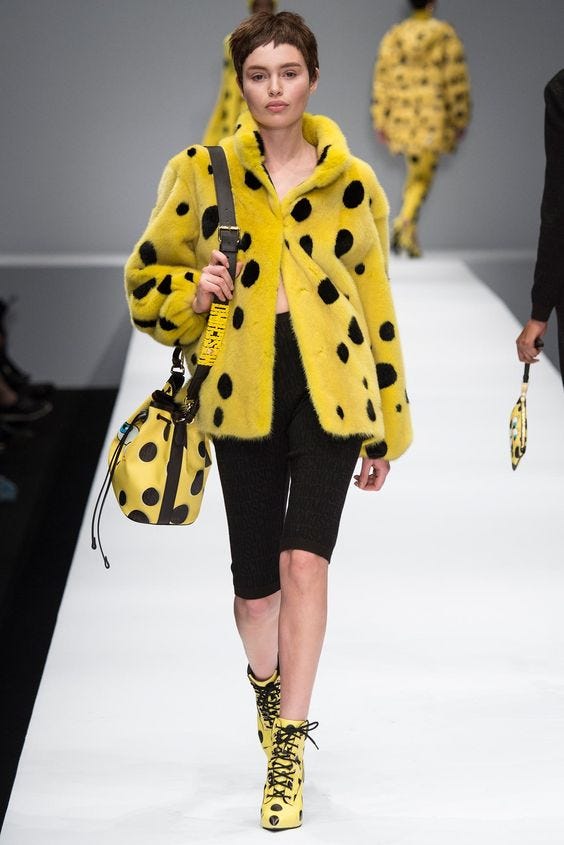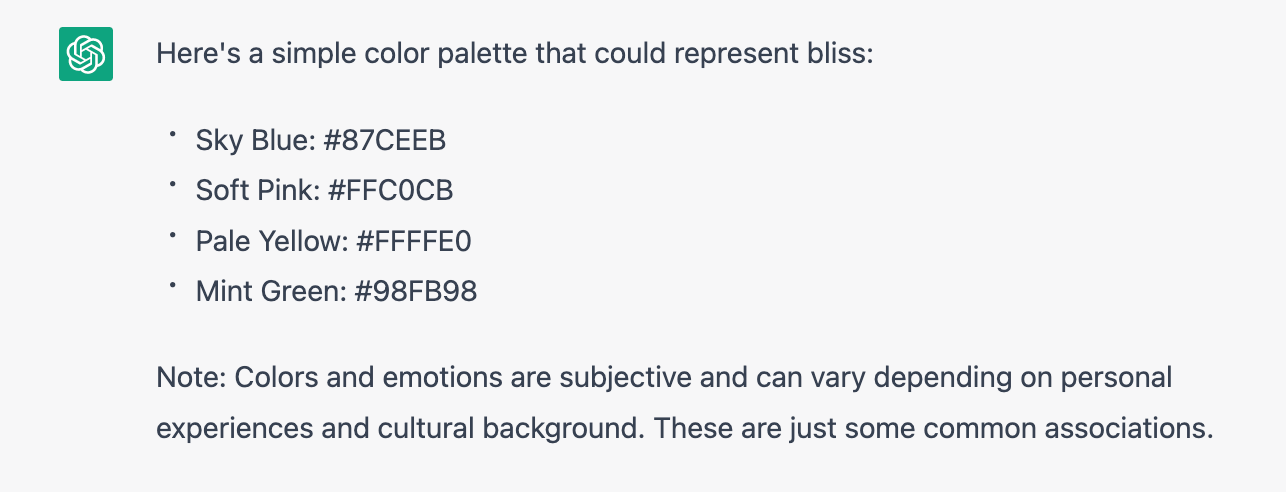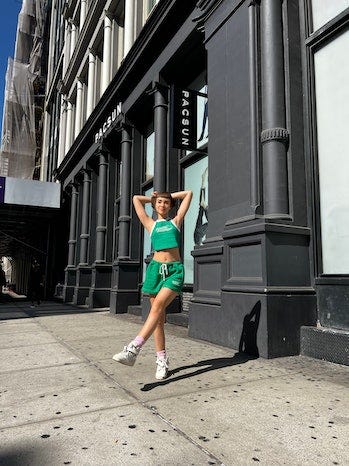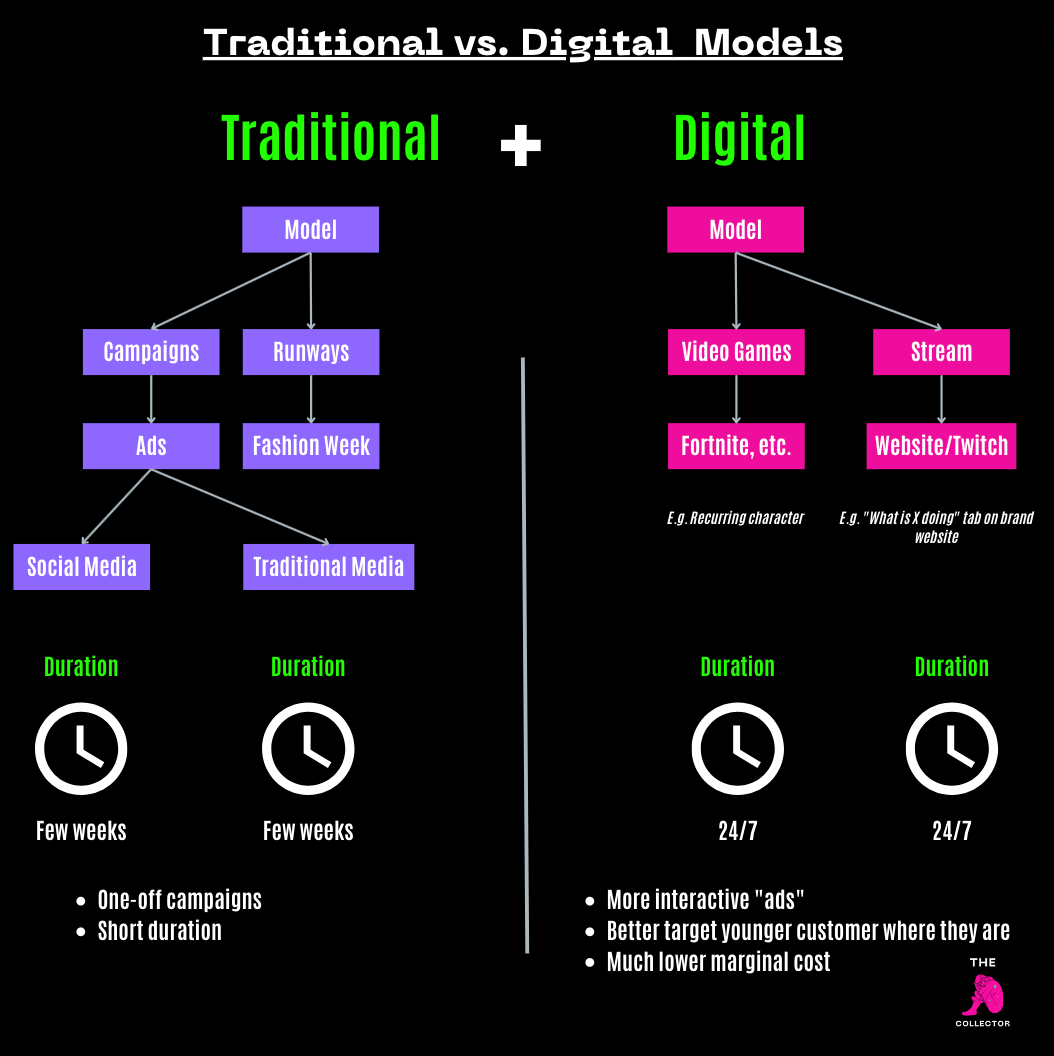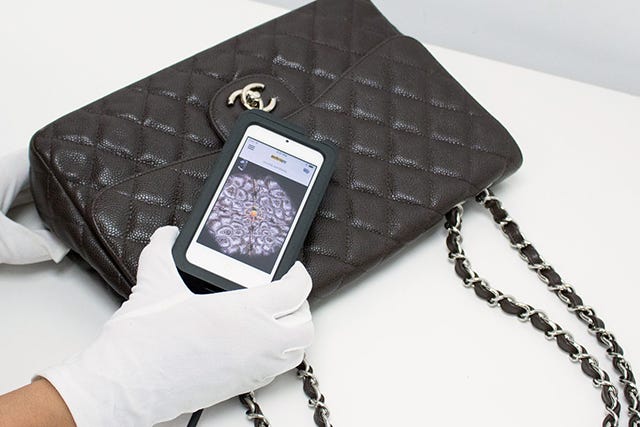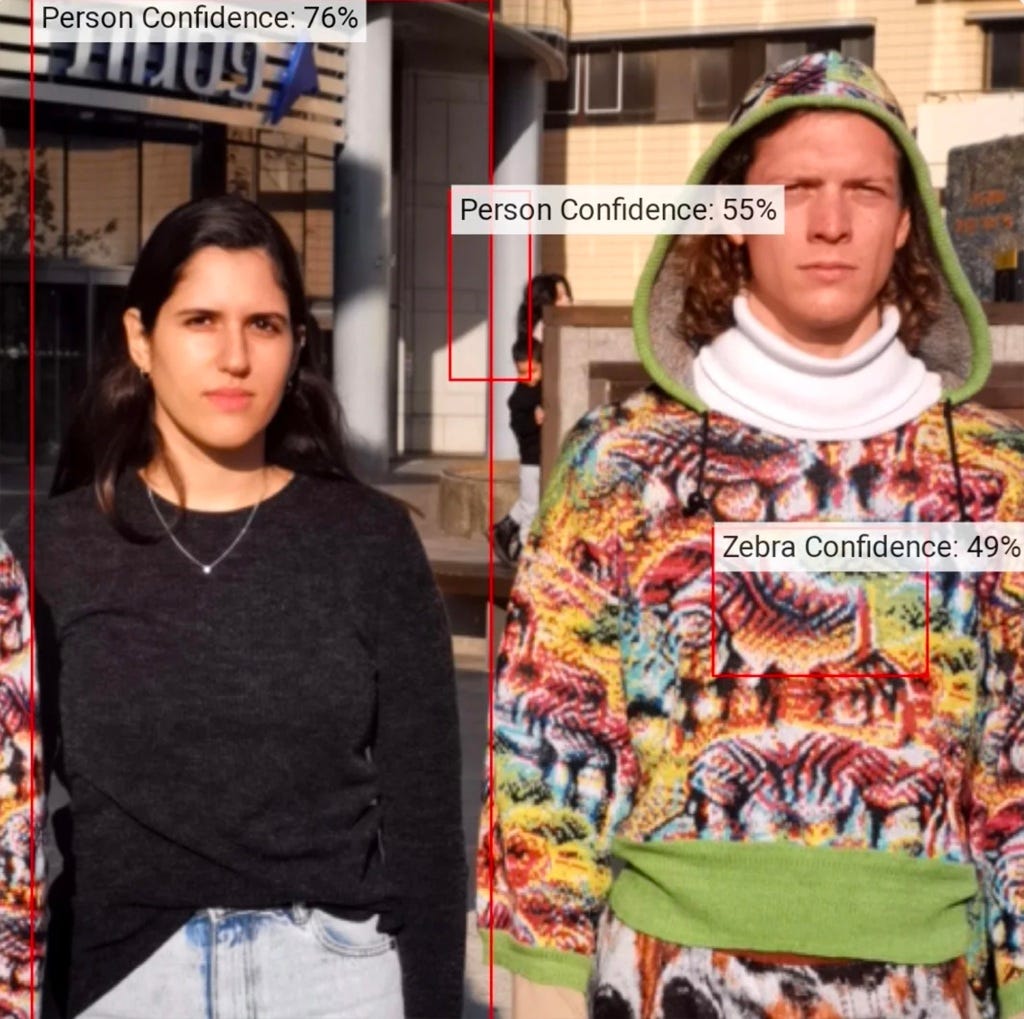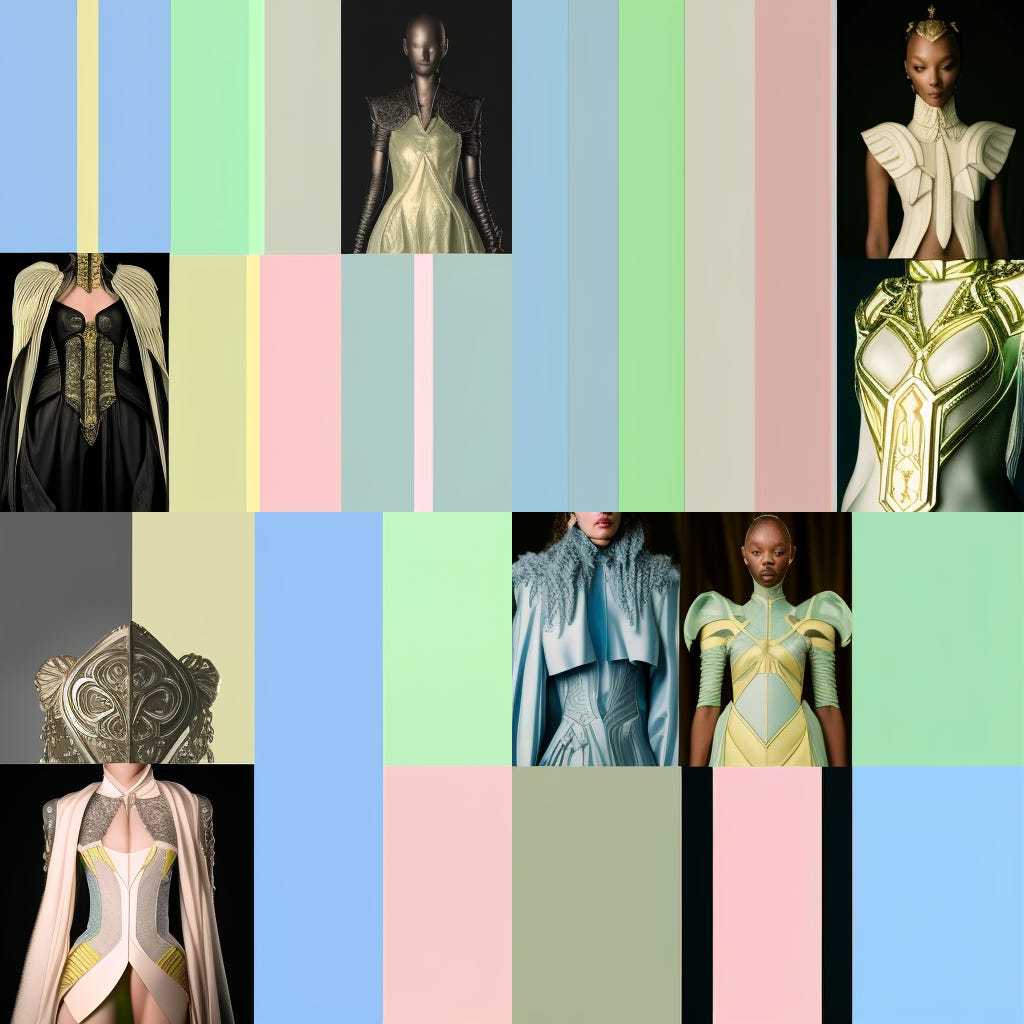The Naked Collector is the home of the latest news and deepest analyses of Web3 Fashion and Culture.
Last week OpenAI revealed ChatGPT Pro while ChatGPT 2 is set to be released soon, this got me thinking about how AI will affect fashion specifically.
In this post, I’ll summarize some of the most important ways it will do that as well as how NFTs will play into all this.
1) Ideation Will Become Seamless
Gone will be the days of sketching for hours in pursuit of a single idea. Mood boards will become more specific, yet creative. Instead of trying to visualize what a Wes Anderson-inspired collection will look like, designers will be able to actually see it.
This will help designers maximize their creativity and the ability to generate unique ideas will be the ultimate differentiators. In addition to movies, previous runway collections serve as an important source of inspiration for designers. Interestingly enough, Midjourney has a decent recollection of historic fashion shows.
To test this, I used the prompt, “Outfit inspired by Moschino's Fall/Winter 2014 ready-to-wear runway show” to test Midjourney’s capabilities. To my surprise, Midjourney captured the pop culture aesthetic of that show pretty well.
Some of the tools fashion designers can utilize currently for ideation are Midjourney, DALL-E, Lexica and Huggingface. However, I wouldn’t be surprised if we see a mainstream text-to-image tool made specifically for fashion designers sometime this or next year.
2) Design and Prototyping Will Become Much Faster
Prototyping and even technical sketches will become a reality. While Midjourney’s measurement generation still needs improvement, we see the proportions and design details almost as if they were done by a human. The AI outputs will undoubtedly improve and probably be capable of generating spec sheets (i.e. fashion design blueprints) in the near future.
In addition, instead of browsing through fabric catalogs, designers will be able to use tools like ChatGPT to summon suitable fabrics for their ideas using ChatGPT.
Color design will also become faster and more intuitive. Even visualizing colors for abstract colors for emotions like “bliss”.
Digital-only designs will feel the impact of AI even more than their physical counterparts. For instance, ChatGPT can already generate (at least partially correct) code for Blender and Unreal Engine. Moreover, we already have text-to-texture functionality while LIDAR (Light Detection and Ranging) technology allows you to scan real-world assets and convert them into 3D in minutes.
The best physical-to-3D scanning apps I’ve tried are Luma AI and Polycam The advancements in text-to-3D will eventually democratize the 3D design process like Midjourney has democratized art generation. This has important implications not only for fashion but also sectors like indie gaming.
Speaking of games, Ready Player Me just announced their DALL-E integration that allows users to customize their avatar’s outfit textures. I used the previous “Outfit inspired by Moschino's Fall/Winter 2014 ready-to-wear runway show” prompt to generate this in Ready Player Me:
While the outputs still aren’t perfect, they’re surprisingly good. This is an important step toward AI-enabled mass personalization. As I wrote in my The Future of Web3 Fashion — Part 2: Generative Art piece:
More ambitiously, generative designs could perhaps be the solution to the mass-customization issue. People want customized products, yet, customizing each product scales poorly. Generative designs scale better. While generative art doesn’t customize to user specifications people often end up identifying with the art or PFPs they buy/mint (based on empirical evidence from two-year full-time participation in the NFT market).
All in all, there’s a reason I mentioned Ready Player Me as one of the projects to watch in 2023 in my State of Fashion 2022 report.
To summarize the range of AI tools and roughly where they could fit in with the existing tools and platforms, I made the visual below.
3) Fashion Models Will Become Infinitely Moldable and Scalable
While we already have digital models like Lil Miquela (the face of PacSun) Shudu and Blawko, these haven’t yet utilized the power of AI.
Introducing AI will:
Make the creation of digital models much easier and cheaper (see point 2).
Give digital-only models scalable personalities through AI. For now, Lil Miquela is a soulless face (or has one-off personas) in visual brand campaigns. What if she could join players on Fortnite and play as herself while wearing PacSun, Supreme or any other brand she has sponsored? While Lil Miquela is already making over $10 per year from her talent agency CAA unlocking a personality would increase this considerably.
Overall, digital avatars with fine-tuned personalities will allow brands to create consistent and scalable brand presence through different ad mediums. Eventually, these models could be plugged into games or movies.
After all, wouldn’t 16-year-old Jimmy feel stronger brand loyalty toward Adidas if he interacted with a digital Adidas avatar inside a game, or face a cool Adidas Final Boss (see below)? However, instead of just generic characters wearing Adidas wearables, the digital model would be the same distinct one as seen on TV, ads, billboards, etc. A digital celebrity of sorts. Think of it as if e.g. Indigo Herz had a distinct personality trained by an AI.
Some interesting projects working on digital avatar AI personalities are Inworld Studio, Character.AI and Replika.
4) Marketing Materials Will Improve
Writing marketing copy and SEO optimization will become more straightforward. Yet, if everyone uses ChatGPT then there will be no relative competitive advantage. It’s the brands that won’t utilize AI tools that will get left behind.
As ChatGPT becomes a paid service (likely) and a backend instead of a frontend, it will likely become a SaaS tool for big companies. Tools like Jasper AI will be the new Office 365 or Adobe business subscriptions.
Initially, there be the quirky “Made with AI” campaigns, however, as the novelty wears off, customer connection will remain supreme. On the bright side, less time on copywriting could mean more time focusing on those customer connections.
5) Consumer Interaction Will Be More Personalized
According to some studies, the use of AR + 3D can reduce returns by up to 40% and increase online shopping conversion rates by up to 97%. More about AR and virtual try-on here.
AI will enhance consumer interaction by:
Making 3D asset creation much more cost-efficient, LIDAR scanning (Section 3). Brands will increasingly utilize 3D marketing materials.
Making AR accessible to all brands via Snapchat virtual try-on lenses. It takes only minutes to create AR brand assets. Below is a tutorial on how I made a Snapchat AR filter in 10 minutes using an AI-generated fashion image.
Improving the fitting process (AI size analysis) and recommendation process (AI tagging) as well as generating more predictable delivery times (AI supply chain tracking).
6) Luxury Item Authentification Will Benefit
Companies like Entrupy and GOAT use AI technology to verify the authenticity of luxury items. The Entrupy iPhone app supposedly takes microscopic images of the product that its machine learning algorithm then compares against its database of millions of records from authentic pieces. GOAT in turn focuses on sneakers and utilizes neural networks trained on 75,000 images of authentic sneakers.
In some ways, AI verification is a competitor to the NFC chip we’re currently seeing in the phygital (digital/physical) space. However, NFC chips have some unique advantages as well.
7) AI Will Become a Cultural Reference
Volatile times have introduced interesting collections in fashion. From the Hippie fashion in the 60s to the opulence of the 80s, AI will do so too. In fact, an Italian clothing startup recently made clothes that confuse facial recognition technology “by tricking the AI-powered algorithm into thinking those wearing the garments are animals”. As much as we will see AI-enabled and co-produced clothing, we will also start seeing a countermovement that focuses on the traditions of clothing production using old more manual methods.
8) AI Will Become the Designer
It’s possible that an AI stack (e.g. ChatGPT + Midjourney/DALL-E) will take over even some of the more creative tasks of fashion design. This will be especially true for fast-fashion brands like Shein. It already uses AI to generate design ideas based on customers’ social media habits, thus, eventually outsourcing the designers as well isn’t inconceivable. As Midjourney and ChatGPT develop, these will be incorporated into new “one-click” design capabilities within existing design software like Clo or entirely new AI software.
To test ChatGPT’s fashion design capabilities, I asked what kind of prompt it would use to create a fashion collection using Midjourney. Here's the result:
Obviously, text-to-image AI is not very good at text generation yet, however, the output is surprisingly good and consistent. The collection has a pretty clear jungle theme and even includes the mood boards it used for inspiration. With some minor tweaks, these outputs could’ve been much better.
Alternatively, I tried incorporating the futuristic materials and “bliss” color palette from Section 2. Here’s the result:
Once again, it produces consistent outputs and reference images.
Why is this meaningful? A few reasons. First, given no additional regulation, Shein and other fast-fashion brands will be able to copy or synthesize designs more easily than before. Second, it opens up the opportunity for new design models. These design models could include:
Perfected recommendations. As the turnaround time between customer data inputs (size, purchase history, likes) and recommendation outputs will be instant, this allows endless AB testing and personalization. No longer will brands be restricted by their existing designs. A sort of mix between the design on demand and pre-selling models. This should naturally increase conversion rates. The process flow could look something like this:
Data (sizes, sex, purchase history, likes) → Instantly processed by AI design software (with tight parameters) → Real-time recommendations of designs that don’t yet exist.
This will drive brands to collect as much data as possible. Obviously, the biggest bottleneck here will be online retailer business models (e.g. Zalando receives commissions for carrying other brands) and the limits of physical production. Something I previously discussed here. Naturally it wouldn’t make sense to produce all AI generated models, but there could be ways to gain intersting insights from customer choices.
Mass customization. As I discussed in The Future of Web3 Fashion — Part 2: Generative Art post, mass customization is an important piece in fashion we’ve yet to unlock. However, this time, instead of the human-written generative art we’ve been seeing on Art Blocks, there will be AI-generated outputs. So if Art Blocks are 1/1/x, purely AI-generated will be 1/1/∞. Thus, it would make sense that there are two mass customization design tracks:
Human-designed (or curated) outputs like Art Blocks (aka the artisan design version or the “digital haute couture”).
Purely AI-designed outputs. The fast-fashion of generative design.
Obviously, there will also be overlaps between the two, e.g. curated AI outputs and respected prompt engineers that should be included in the first category.
The exciting thing here for NFT technology is that it will be required to prove digital scarcity and provenance. There doesn’t seem to be a better alternative solution for enforcing these. After all, people won’t and shouldn’t blindly trust the designer or the brand regarding collection scarcity.
9) “Operating Systems for Fashion” Model Will Proliferate
AI will help create “operating systems for fashion”. This will take the fashion idea-to-consumer process to another level. Access to these operating systems could be granted via traditional Web2 subscription models or NFT-gated access.
CALA and PlatformE are two examples of such operating systems. They enable brands to design with very little (if any) design knowledge. CALA already includes AI design in its offering.
Some Web3 projects are trying also to create such operating systems. I recently came across a Web3 project called Phiber, which is trying to accomplish something along these lines. However, it seems like they still have a long way to go.
There are also more established Web3 projects like Digitalax that have had the operating system design in mind more or less from the beginning. Based on my discussions with Web3 projects like The Fabricant, it also seems that more and more Web3 fashion projects are gravitating toward this model. Portions of the highlighted segments of the “Web3 Fashion Landscape“ visual below have already or are looking to shift toward the operating system model.
Even projects like 9dcc and Ready Player Me which are in the phygital and metaverse categories respectively, seem to gradually be going down this route.
10) AI x Web3 Will Provide Access and Authenticity
While AI on its own will revolutionize the fashion industry, combining it with Web3 further expands the innovation spectrum.
ERC20 tokens = utility tokens for AI computation resources. Projects like Fetch AI are doing something similar to this. From a fashion-specific perspective, this could mean, for instance, X tokens per AI garment generation.
NFTs = token-gated access to AI creative hubs + proof of scarcity.
If crypto and NFTs are the value layer of the internet, then it makes sense these are integrated into the new creative layer of the internet. I’ve written in-depth on how Web3 and AI could be integrated here.
Conclusion: New Production Models and Faster Demand
The fashion industry will undoubtedly have to adjust to a post-AI world. As AI enables a faster turnaround time with higher creativity and consumers have increasingly short attention spans, the term “fashion season” may start to have a different meaning in the future.
Social media is increasingly shifting away from a top-down model to a bottom-up one.
After all, in recent years entertainment has shifted from
Centrally curated AND centrally produced → TV, to
Centrally curated BUT user-produced content → Instagram, to
User curated AND user produced → TikTok (not perfectly user curated but close)
At the same time, consumer attention spans have gone down and are dictated by pop culture trends by the likes of Squid Game and Stranger Things. Not only do we see this phenomenon in TikTok trends but also in fashion. As we move forward, fashion cycles will shorten and may become less meaningful. In their place, cultural cycles and user-generated fashion will dominate. At some point, it will be easy to create a beautiful fashion collection with very little effort (just like it’s easy to create beautiful art using Midjourney). Ultimately, the most creative and culturally resonant collections with interesting backends will gain popularity among consumers.
Going Forward
Thanks for reading, I believe we have some of the brightest people in the space reading this newsletter. However, I’d love it if you could share this newsletter with others. The more people read educational posts like this the more the entier Fashion NFT space benefits. We just have to get peoples’ attention.
I work tirelessly to get you the best insights for free, in return every single share or subscription matters.
As an added incentive, in the future, I’ll be looking to provide extra benefits for people who share my posts (e.g. early access, exclusive data), as I did with this post. Because Substack doesn’t have an in-built referral program like some other newsletter platforms, I have to get a bit creative :)
Thanks for Reading!
If you want to work with me (sponsored posts/research/consulting) just send me a Twitter DM or an email to enquiries@nakedcollector.xyz. I’m constantly looking to work with new projects.
Also, feel free to DM me topics you want to see covered in the future.
Author Bio
I focus on the cross-section of NFTs, crypto and fashion:
Naked Collector has been the top Web3 Fashion research/data source since 2021
5+ years of experience in crypto markets
Part of 100+ NFT communities






